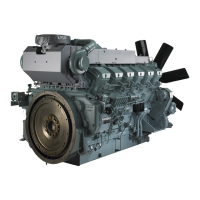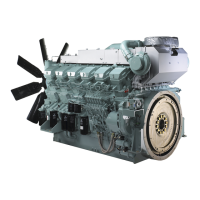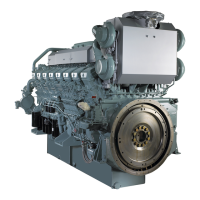Chapter 1 BASIC SAFETY PRECAUTIONS
1-7
Conduct proper maintenance of
air cleaner/pre-cleaner
The major cause of abnormal wear on engine parts
is dust entering with intake air. Worn parts result in
an increase of oil consumption, decrease of output,
and starting difficulties. Conduct maintenance of
the air cleaner/pre-cleaner according to the follow
-
ing directions to ensure optimum air filtering perfor-
mance.
• Do not conduct maintenance of the air cleaner/
pre-cleaner while the engine is operating.
Without the air cleaner/pre-cleaner in place, the
turbocharger can suck foreign particles into the
engine, decrease the load immediately so that
the engine operates at appropriate output and
load.
• When removing the air cleaner, do not allow dust
attached on the air cleaner/pre-cleaner to enter
into the engine.
• If equipped with a dust indicator, conduct mainte-
nance only when the clog warning sign appears.
While servicing the air cleaer/pre-cleaner, do not
let dust enter into the air cleaner/pre-cleaner,
damage or deform the element.
Observe safety rules at workplace
Observe the safety rules established at your work-
place when operating and maintaining the engine.
Do not operate the engine if you are feeling ill.
Operation of the engine with reduced awareness
may cause accidental operations that may result in
accidents. In such case, you should inform your
supervisor of your condition.
When working in a team of two or more persons,
use specified hand signals to communicate among
the workers.
Wear proper work clothes and
protective gear
Wear the work clothes specified by your workplace.
Wear a hardhat, face shield, safety shoes, dust pro-
tective mask, gloves and other protective gear as
needed.
When handling compressed air, wear safety gog-
gles, hardhat, gloves and other necessary protec-
tive gear. Compressed air may cause personal
injury when not wearing the proper protective gear.
Use appropriate tools for mainte-
nance work
Use appropriate tools according to the type of
maintenance work, and use them correctly.
If tools are damaged, replace with new tools.
Cautions concerning transporta-
tion
When transporting the engine using a truck, con-
sider the engine weight, width and height to ensure
safety. Abide by the pertinent laws and regulations.
Do not operate engine continu-
ously under low load
When operating the engine with a 30 % load or
lower, limit each operation to 10 minutes. Operating
the engine under low load tends to result in
unburned fuel, which can adhere on internal engine
parts to cause malfunctions and shorten the engine
service life.
Ventilate the engine room suffi-
ciently
Be sure to provide sufficient ventilation in the
engine room. Insufficient air in the room can cause
the engine temperature to rise and the output
power and performance to lower.
It is highly recommended to calculate the required
amount of air supply to the engine and install an
appropriate ventilation system before installing an
engine.
Do not touch high-pressure injec-
tion fuel
Should injected fuel leak from a fuel injection pipe,
do not touch the spurting fuel.
Fuel in the fuel injection pipes is under high pres-
sure. Touching high-pressure fuel can cause the
fuel to penetrate the skin and result in gangrene.

